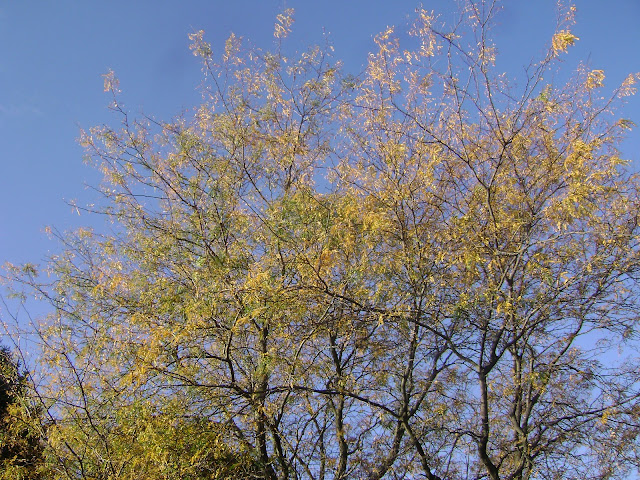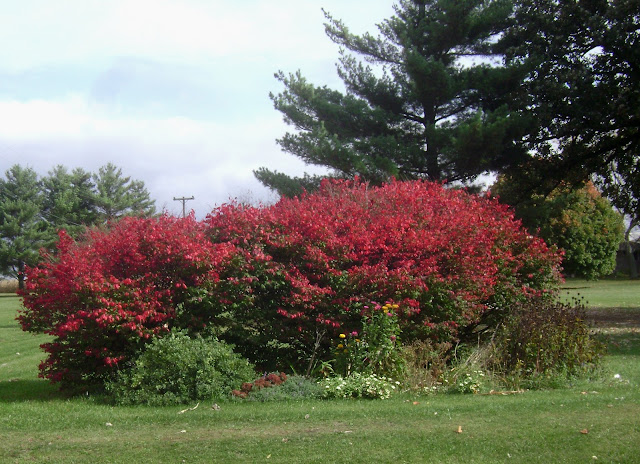The older I get, the more I love autumn. Crisp, cool days--a welcome reprieve from the summer's sweltering heat--the smell of ripe apples falling from the tree, the hum of combines harvesting the fields. But most of all, the strongest sensory impression is watching the trees change color from their uniform summer green to glorious shades of gold, orange, and red. What a glorious show Mother Nature puts on before the big winter sleep.
Each year I like to participate in Dave's
Fall Color Project as a way of recording the beauty of fall. This year the show began in late September and continued through the month of October.
The white ash nearest the front of our house is always the first to turn. Its leaves turn a deep purple and then drop quickly before the rest of the trees have even begun to think about changing.
Another ash tree nearer to the road begins the change a little later. As the first harbingers of the fall color show, they make me a little sad as I hear the reports of spottings of the dreaded Emerald Ash Borer closer and closer each year. I'm afraid these trees' time may be limited.
By early October the honey locust trees create a canopy of bright gold.
The redbud tree echoes this color, which looks especially dazzling on a bright sunny day.
Driving downtown to run some errands, I always pass my favorite tree in the autumn. I was too slow this year, because by the time I remembered to take my camera along, this large maple had already dropped most of its leaves. Just a week before, it was a vision of orange, covered in masses of glowing leaves.
I'm not so sure the homeowners appreciate this tree as much as I do, though:)
Down a back street, there were other maples, however, that were still full of leaves. This one is beautiful, but how about another look at it . . .
. . . for a full frontal view--not quite so pretty now, is it? There are several trees like this around town, but they don't seem as noticeable until fall. All of them are in older neighborhoods where I'm sure the power lines existed before the trees were planted--a good illustration for careful site selection when planting new trees.
I had hoped to take more photos around town and maybe even visit the nearby forest preserve, but time got away from me. As it was, there was plenty of fall color in my own front and back yards. Driving back home, the small roadside garden isn't much to look at in early October, but no one much notices the shriveled plants and dried seedheads when the burning bushes put on such a display.
The vivid red of these shrubs scream to be noticed by anyone driving past.
While the trees command most of the attention in the fall, if you take the time to look closely, you will notice the garden has its own fall wardrobe. Everyone notices the hydrangea blooms that age so gracefully, but the foliage is equally pretty. In early October the leaves began to take on tinges of a purplish-red.
Today, when I walked out to the garden for the first time in over a week,
the change was even more dramatic.
The leaves of the fothergilla show a variety of colors, though it, like the rest of the new shrubs I planted in front of the house last fall, was a disappointment this year. I think the drought really affected them, and I'm hoping they do better next year.
No disappointment here, however--the
Amsonia tabernaemontana positively glows in the early morning light of early November.
Even the common rough-eared dogwood, much less refined than its sophisticated relatives, put on some bright colors this fall.
Back to the trees . . . the old Burr Oak isn't known for its color, its leaves turning shades of bronze.
But this granddaddy of all my trees doesn't need a gaudy appearance to be appreciated at any time of year. Its size and age are enough to earn it respect.
In my yard, Mother Nature has apparently decided to save the best for last. When the other trees have already lost their leaves, the maple is just beginning its transformation.
First, a few leaves at the top begin to change, and as the days pass by, the progress continues slowly down the tree, until it all is covered in a brilliant orange.
The timing couldn't be more perfect--this was how it looked on the day of our Halloween party, just the right accent for orange pumpkins!
I'm a little later than I had intended in posting my contribution for this year's fall color project--I've been out of town for the past week, visiting my Daughter and new Son-in-law and seeing some fall color of a different sort . . .
. . . I think you can guess exactly where I have been:) When I arrived home last night, I was surprised at how warm it still was here in central Illinois, but I also noticed this morning that all the trees are now bare. I'm glad I didn't leave before having time to enjoy this year's beautiful show of fall color.






































